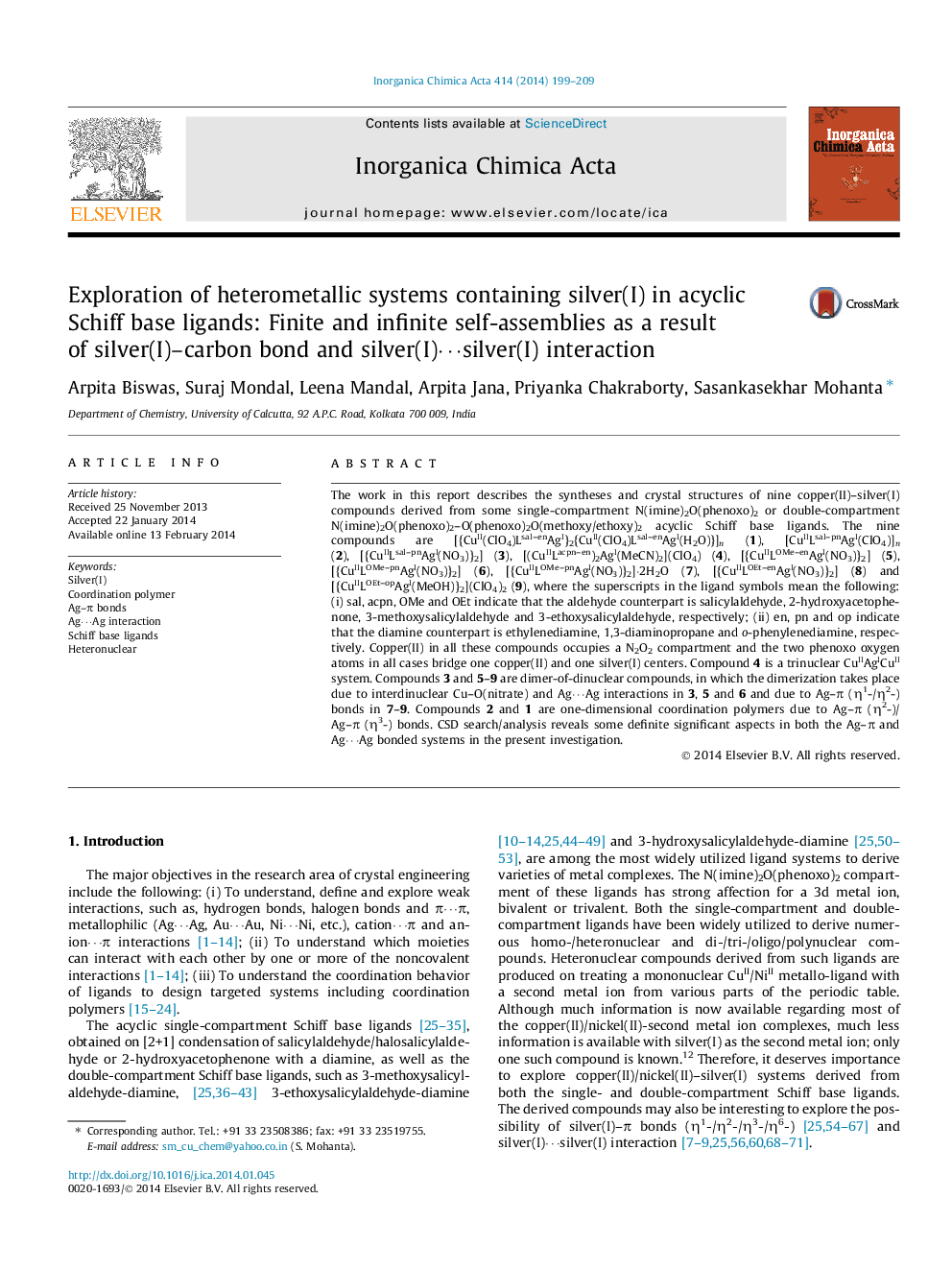| Article ID | Journal | Published Year | Pages | File Type |
|---|---|---|---|---|
| 1305684 | Inorganica Chimica Acta | 2014 | 11 Pages |
•Nine new heterometallic complexes containing copper(II) and silver(I).•The second examples of 3d–silver(I) compounds from acyclic Schiff base ligands.•Two compounds are coordination polymers due to Ag–π (arene; η1-/η2-/η3-) bonds..•Six dimer-of-dinuclear systems due to silver(I)⋯silver(I) interaction.•CSD survey reveals some definitely significant aspects.
The work in this report describes the syntheses and crystal structures of nine copper(II)–silver(I) compounds derived from some single-compartment N(imine)2O(phenoxo)2 or double-compartment N(imine)2O(phenoxo)2–O(phenoxo)2O(methoxy/ethoxy)2 acyclic Schiff base ligands. The nine compounds are [{CuII(ClO4)Lsal–enAgI}2{CuII(ClO4)Lsal–enAgI(H2O)}]n (1), [CuIILsal–pnAgI(ClO4)]n (2), [{CuIILsal–pnAgI(NO3)}2] (3), [(CuIILacpn–en)2AgI(MeCN)2](ClO4) (4), [{CuIILOMe–enAgI(NO3)}2] (5), [{CuIILOMe–pnAgI(NO3)}2] (6), [{CuIILOMe–pnAgI(NO3)}2]·2H2O (7), [{CuIILOEt–enAgI(NO3)}2] (8) and [{CuIILOEt–opAgI(MeOH)}2](ClO4)2 (9), where the superscripts in the ligand symbols mean the following: (i) sal, acpn, OMe and OEt indicate that the aldehyde counterpart is salicylaldehyde, 2-hydroxyacetophenone, 3-methoxysalicylaldehyde and 3-ethoxysalicylaldehyde, respectively; (ii) en, pn and op indicate that the diamine counterpart is ethylenediamine, 1,3-diaminopropane and o-phenylenediamine, respectively. Copper(II) in all these compounds occupies a N2O2 compartment and the two phenoxo oxygen atoms in all cases bridge one copper(II) and one silver(I) centers. Compound 4 is a trinuclear CuIIAgICuII system. Compounds 3 and 5–9 are dimer-of-dinuclear compounds, in which the dimerization takes place due to interdinuclear Cu–O(nitrate) and Ag⋯Ag interactions in 3, 5 and 6 and due to Ag–π (η1-/η2-) bonds in 7–9. Compounds 2 and 1 are one-dimensional coordination polymers due to Ag–π (η2-)/Ag–π (η3-) bonds. CSD search/analysis reveals some definite significant aspects in both the Ag–π and Ag⋯Ag bonded systems in the present investigation.
Graphical abstractThis work presents one trinuclear CuIIAgICuII, six dimer-of-dinuclear (CuIIAgI)2, one dinuclear CuIIAgI-based 1D and one hexanuclear (CuIIAgI)3-based 1D compounds. These are only the second examples of 3d-silver(I) compounds derived from single-/double-compartment acyclic Schiff base ligands. Ag–π bond and Ag⋯Ag interaction are responsible for the formation of dimeric or polymeric self-assemblies herein.Figure optionsDownload full-size imageDownload as PowerPoint slide
